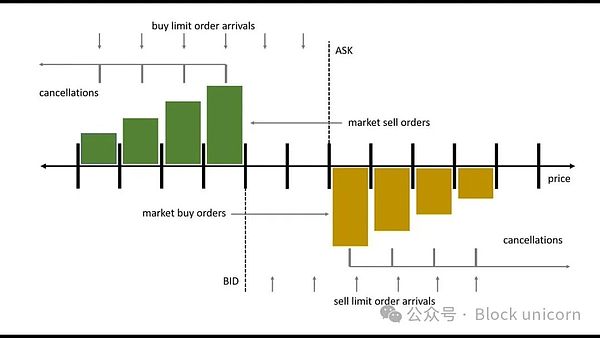
Article author: arnaud710 Article compilation: Block unicorn
Market makers are the heroes behind the scenes to ensure smooth transactions. They are like stage managers on the trading floor, maintaining market liquidity and trading seamlessly while balancing countless factors to maintain stability. Building an efficient market-making system is like building a high-performance car—every part needs to work perfectly to deliver top performance.
What is market making?
The core of market making is to provide liquidity to the financial market and provide trading opportunities for securities by continuously quoting the buying price (Bid) and selling price (Ask) . Market makers make money from the Bid-Ask Spread - which is the difference between the bid and ask prices. You can think of them as friendly local store owners who always have something to sell but are also willing to repurchase items, ensuring buyers and sellers don’t leave empty-handed.
The bid-ask spread: the core of market making
The bid-ask spread is the key to market makers' profitability. It not only covers the risks and costs of holding inventory and facilitating transactions, but also determines whether market makers can attract traders.
Wider spreads: Although they can lead to higher profits, they may scare away traders looking for tight prices.
Narrow spread: can attract more transactions, but the profit margin is lower.
The key is to find a "sweet spot" - if the price difference is too wide, your inventory will be unsaleable; if the price difference is too narrow, your profits will be very little. A well-adjusted spread can help market makers cover costs while remaining competitive.
Inventory Holding Premium (IHCi): The Art of Balance
Market makers will hold a certain inventory of securities to facilitate trading
The cost of holding inventory: comes from two main Aspect
1. Opportunity cost of funds
Holding inventory takes up funds that could have been used in other investments. If the security price The higher the price, the higher the price difference required to cover this cost. Think of this as higher-end products requiring higher pricing because more resources are required to produce them.
2. Risk of price fluctuation
The securities market is highly volatile, and price changes may result in losses. If the market price changes in an unfavorable direction, market makers will suffer losses. In order to prevent this risk, market makers usually widen the price difference to create an unfavorable price Changes provide a buffer.
This approach accounts for the interplay between a security's price, volatility and holding period and ensures that premiums adjust with market conditions. .
Adverse selection cost (ASCi): Guarding Against Information-Advantaged Traders
Adverse selection refers to the In order to prevent traders from suffering potential losses due to these information advantages, market makers need to adjust the spread to protect themselves. text-align: left;">For example: If someone knows that a stock is about to rise sharply, they may buy it at the asking price, and if the stock price does not rise as expected, the market maker may lose money. By incorporating ASCi into the spread , market makers can mitigate these risks caused by information asymmetry
Probability of information trading (P_I): Assessing risks
Assessing the likelihood of facing an information-advantaged trader is a complex exercise that requires analyzing patterns and market data to determine whether a trade was based on inside information. Factors such as trading frequency, trading volume, and historical price movements all affect this Judgment.
Higher P_I: means there is greater risk of adverse selection and market makers may widen the spread.
Lower P_I: less risk, spreads can be narrowed, encouraging more trading activity.
Competition proxy (H′): measuring market competition
Competition among market makers will affect the width of the spread. The more intense the competition, the narrower the spread is usually because market makers need to attract traders. H′ can be calculated by the concentration of market makers in the market for a specific security:
Formula: H′=V iXH′ = \frac{V_i}{X}H′= XVi
Vi semantics>V_iVi: Volume contributed by a specific market maker
XXX: total transaction volume.
A higher H′ value indicates less competition and higher concentration, and the price spread may be wider; when competition is fierce, the price spread tends to narrow.
Use vivid metaphors to easily understand the core principles of market making
Opportunity cost: Imagine that your capital is your best salesperson. If you keep them busy making cold calls all day instead of taking high-value orders, then you You will miss out on huge profits. By allocating funds appropriately and using them wisely, you can ensure that your "money-making experts" focus on doing business, so that you can widen the price difference and earn more profits.
Volatility: Think of volatility as a person jumping up and down on a trampoline. You can never predict the height or direction of the next jump. Market makers must be steady and cannot be fooled by these sudden ups and downs. The market is off the rails
Adverse selection: Adverse selection is like watching a football match. Some spectators secretly know the outcome of the match. Market makers need to set price spreads accurately to prevent being led by these cunning "insider spectators" and falling into their trap.
Building a complete market-making system is much more complicated
All in all, the art and science of market making plays a key role in ensuring market liquidity and smooth trading. Building an efficient market-making system is a technical activity that combines art and science. It requires both deep technical knowledge and precise strategic adjustments, as well as rapid adaptation to rapidly changing market dynamics.
Through careful operation, market makers ensure that the financial market always maintains liquidity and efficiency, providing important support for the stable development of the entire market ecosystem.












